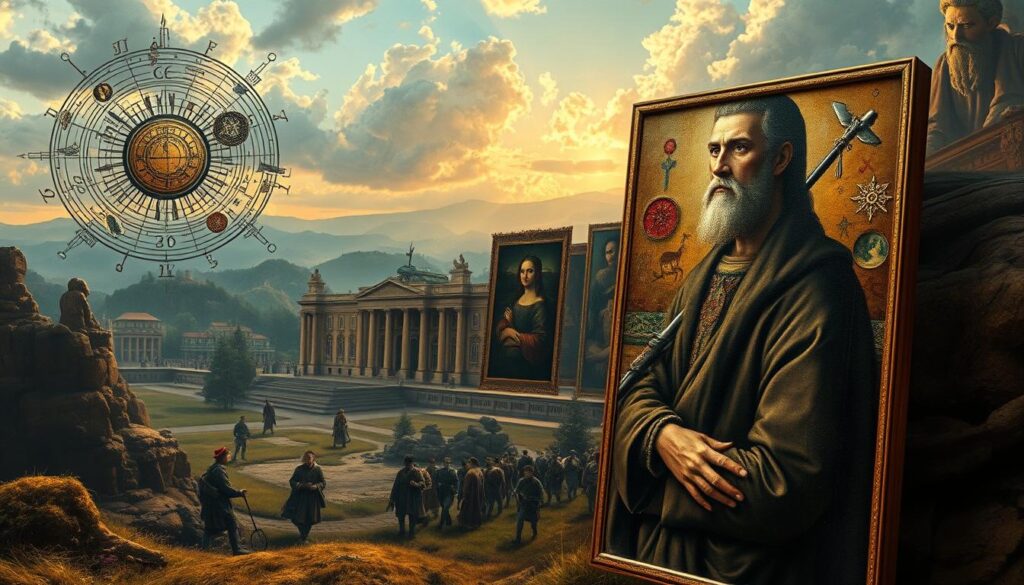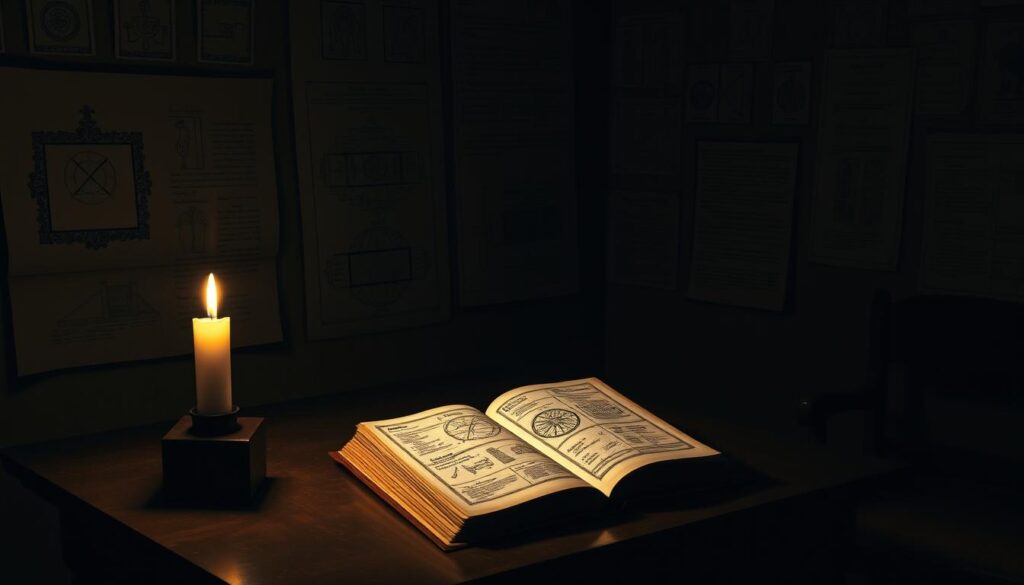Unveil the Hidden Symbolism in Iconic Artworks
Unveil the Hidden Symbolism in Iconic Artworks, Artistic symbolism is key in iconic paintings. Many famous artworks hide symbols and meanings. The Mona Lisa’s smile and The Starry Night’s clouds are more than beauty. They open a door to a world of symbolism and hidden messages.
Exploring iconic paintings, we find artistic symbolism everywhere. It shows the artist’s inner world and their time’s culture. This symbolism adds depth and invites viewers to explore deeper, finding hidden meanings.

Discovering hidden symbolism in iconic artworks is exciting. It’s a journey filled with surprises and new insights. We’ll see how color, light, and symbols enrich these beloved works.
Introduction to Artistic Symbolism
Artistic symbolism is a language that touches us deeply. It conveys emotions, ideas, and experiences beyond words. Artists use iconic paintings and hidden symbols to share complex messages, inviting us to join in the creative journey.
Key Takeaways
- Artistic symbolism is a powerful tool used in iconic paintings to convey hidden meanings and messages.
- Hidden symbols in famous artworks can reveal the artist’s inner world and the cultural context of their time.
- Iconic paintings often contain multiple layers of meaning, inviting the viewer to engage with the piece on a deeper level.
- The use of artistic symbolism in iconic paintings adds depth and complexity to the artwork.
- Uncovering the hidden symbolism in iconic artworks can lead to new insights and discoveries about the artist and their creative process.
- Artistic symbolism is a language that speaks to us on a deep and intuitive level, conveying emotions and ideas that transcend words.
The Language of Hidden Symbols in Famous Artworks
Art has long been a way for artists to share complex ideas and feelings. They use subtle hints and allusions to do this. Throughout art history, artists have added depth and meaning to their work with hidden symbols. These symbols often draw on cultural significance to connect with their audience.
Looking at famous artworks with hidden symbols helps us appreciate their art history more. From ancient times to today, artists have used these symbols to share meaning and tell stories.
The cultural significance of these symbols is huge. They often show the values and beliefs of the time they were made. By understanding these symbols, we get a deeper view of the artwork and its role in art history.
Decoding Religious Symbolism in Renaissance Masterpieces
The Renaissance art is special because it can share deep ideas and feelings through symbols and images. Artists like Leonardo da Vinci and Michelangelo put their own spin on religious themes. They hid messages in their work. This movement brought back the love for ancient Greek and Roman culture, seen in many famous paintings.
Colors like blue and gold were used to show divinity and royalty. Angels, saints, and biblical figures were also used to represent virtues or moral values. Looking into these symbols helps us understand the meaning behind these famous works.
Here are some key examples of Renaissance art that showcase religious symbolism:
- The Last Supper by Leonardo da Vinci, which features a range of symbolic elements, including the use of bread and wine to represent the body and blood of Christ.
- The Sistine Chapel ceiling by Michelangelo, which depicts scenes from the Book of Genesis and features a range of symbolic figures and imagery.
Exploring religious symbolism in Renaissance art helps us appreciate these iconic works more. Symbols like color, imagery, and allegory still captivate us today. They give us a glimpse into the values and beliefs of the past.
The Secret World of Color Symbolism
Color theory is key in art, as colors can stir emotions and carry special meanings. Artists use color to share ideas, values, and cultural views. Think of the bold reds and blues in Renaissance art or the golden Byzantine mosaics. Color is a powerful tool for artists to express and tell stories.
Colors mean different things in various cultures and times. For example, red is often seen as power, passion, and divine love. Blue is connected to divinity and royalty. Gold stands for wealth, divinity, and eternal life. Knowing these color meanings can make us appreciate art more.
Exploring Color Symbolism in Art
Artists have always used color to share feelings, ideas, and cultural values. By looking into color theory and symbolism, we understand art better. Colors like red for passion or blue for divinity are crucial in art and culture.
Color Symbolism in Different Cultures
Different cultures have their own color meanings, showing their unique histories and beliefs. For instance:
- In Western cultures, white is seen as purity and innocence.
- In many Asian cultures, red is a sign of good luck and prosperity.
- In some African cultures, blue is connected to spirituality and the divine.
By exploring these differences, we can appreciate the many ways color is used to share meaning and artistic expression.
Animal Symbolism Throughout Art History
Animal symbolism has been key in art history. Different cultures used animals to share meanings and stories. The artistic representation of animals has greatly influenced our view of various cultures and their values.
From the regal lions of ancient Egypt to the fine birds in Japanese ukiyo-e prints, animals have been symbols and motifs for centuries.
The cultural significance of animal symbolism is clear in how cultures use animals to represent life’s aspects. For instance, the eagle symbolizes power and strength across many cultures. The snake, on the other hand, stands for renewal and change. Animal symbolism in art allows artists to express complex ideas and feelings subtly yet powerfully.
Some examples of animal symbolism in art include:
- The lion, which represents courage and strength in many cultures
- The dragon, which represents good luck and prosperity in Chinese culture
- The butterfly, which represents transformation and renewal in many cultures
Exploring animal symbolism in art helps us understand the cultural and historical context of the art. The use of animal symbolism in art shows the power of art to convey meaning and tell stories that last beyond time and culture.
Hidden Messages in Dutch Golden Age Paintings
Dutch Masters are famous for their symbolic coding and artistic expression. The Dutch Golden Age was a time of great cultural and artistic growth. Many paintings from this era have hidden symbols and meanings that show the values of the time.
The use of symbolic coding in Dutch Golden Age paintings lets viewers see the artwork in different ways. For instance, still-life paintings might show symbols of wealth and status. Genre scenes might show everyday life with hidden moral messages.
Uncovering the Meanings
Some common symbols found in Dutch Golden Age paintings include:
- Skulls, which represent vanitas and the fleeting nature of life
- Fruits and flowers, which symbolize abundance and fertility
- Domestic scenes, which highlight the importance of family and household
By understanding the artistic expression and symbolic coding of Dutch Masters, viewers can appreciate the artwork more. They can also understand the cultural context in which it was made.
The Da Vinci Code: Separating Fact from Fiction
Leonardo da Vinci’s works are full of artistic mystery. Many of his paintings have hidden symbols and meanings. His art, like the Mona Lisa and The Last Supper, still fascinates people all over the world.
Da Vinci’s use of hidden symbols shows his intellectual curiosity. He was deeply interested in the world around him. His art reflects the cultural values of the Renaissance, a time of great change in art and science.
Some of the key themes and symbols in da Vinci’s work include:
- Use of geometric shapes and proportions
- Incorporation of natural imagery and symbolism
- Exploration of human emotion and psychology

By looking into da Vinci’s life and work, we can understand the artistic mystery around him. His cultural significance goes beyond his art. His inventions and scientific discoveries still inspire and influence many today. As we explore Leonardo da Vinci’s world, we see the lasting impact of this true Renaissance man.
Modern Interpretations of Classical Symbols
Today’s art scene is seeing a fresh take on old symbols. This artistic expression spans many mediums, from digital art to street art. Artists use these to share their views.
In our digital world, symbols are evolving fast. Artists like Refik Anadol and Banksy are reusing classic symbols to share new stories. This mix of old and new has created a unique contemporary art that’s both deep and beautiful.
- Digital media for new artistic forms
- Modern twists on old symbols
- Combining cultures for a unique style
As symbolic evolution keeps changing art, it’s exciting to see what’s next. How will artists keep redefining traditional symbols and creating new art?
Mythological References in Famous Paintings
Mythology has always inspired artists, with many famous paintings using mythological themes. These paintings reflect the values and beliefs of their time. They tell stories and convey meaning through these references.
Greek and Roman Influences
Many famous paintings show the impact of Greek and Roman mythology. Botticelli’s “The Birth of Venus” and Caravaggio’s “Medusa” are examples. These works often feature mythological figures and scenes, exploring themes like love, power, and mortality.
Norse and Celtic Symbolism
Norse and Celtic symbolism also shaped art. Celtic manuscripts feature intricate knotwork, while Norse mythology’s landscapes are dramatic. These symbols add mystery and wonder to art.
Exploring mythological references in famous paintings helps us understand their artistic inspiration and cultural significance. Whether from Greek and Roman or Norse and Celtic sources, these references enrich the paintings. They invite viewers to think about the themes and motifs depicted.
Political and Social Commentary Through Symbols
Art has long been a powerful medium for social commentary. It lets artists share their views on the world. Through artistic expression, they can share complex ideas and critique society. Symbols in art are especially good at conveying cultural significance and starting important talks.
Many artists have used symbols to challenge social and political norms. For instance, William Hogarth’s satirical prints are a classic example. He used symbols and imagery to comment on the social issues of his time. His work was a powerful tool for change.
Today, artists still use symbols for social commentary and to highlight cultural significance. From the protest art of the 1960s to today’s artists, symbols remain a key tool. They help artists express themselves and bring about social change.

The impact of symbolic coding in art is vast. It touches many areas of society, including:
- Challenging cultural values and promoting social change
- Providing a platform for artistic expression and social commentary
- Inspiring critical thinking and conversation about important issues
The Role of Geometric Shapes and Numbers
Geometric shapes and numbers have been key in art for ages. They show up in Islamic mosaics and modern art’s geometric abstractions. These forms and patterns carry meaning, create harmony, and show cultural values.
Sacred geometry in art is a great example. It uses geometric shapes and numbers to make meaningful, symbolic art. It’s based on the idea that certain shapes and patterns have spiritual importance, linking us to the divine.
Geometric Patterns in Art
Geometric patterns appear in many art forms, like architecture, painting, and sculpture. They bring balance and harmony, and carry symbolic meanings. For instance, the golden ratio in art shows how numbers can balance and harmonize.
Numerical Symbolism in Art
Numerical symbolism is also vital in art. Numbers can mean different things and add rhythm and harmony. For example, the number seven often means spiritual significance, completion, and perfection in art.
Here are some examples of numerical symbolism in art:
- The golden ratio in architecture and design
- Geometric patterns in Islamic art
- Numerical sequences in modern art
Understanding Artist Signatures and Personal Symbols
Artist signatures and personal symbols are key in art. They share meaning, show identity, and reflect culture. Artists use them to stand out and share their unique vision. For example, Vincent van Gogh’s signature is famous, and his symbols, like the cypress tree, deepen his art.
Artists use symbols to share their thoughts and feelings. Frida Kahlo, for instance, used symbols to show her Mexican roots and personal struggles. This way, artists connect with viewers, creating empathy and understanding.
Art isn’t just about the work; it’s also about how artists present themselves. Signatures and symbols are crucial. They help artists claim their work and show their identity. By looking at these, we learn more about the artist’s expression and symbolism.
Some important things about artist signatures and symbols include:
- Unique style and vision
- Cultural values and heritage
- Personal experiences and emotions
- Artistic expression and identity
These elements make each piece of art special and a window into the artist’s soul.
Conclusion: The Timeless Language of Artistic Symbolism
Exploring artistic symbolism in famous iconic paintings shows its lasting impact. This cultural significance has touched many through the ages. It has inspired artists from the Renaissance to today’s digital creators.
Looking into Da Vinci’s use of sacred geometry or the animal symbols in Dutch Golden Age art, we gain a new view. These discoveries make us appreciate these artistic masterpieces more. Symbols help artists share their views on life, from the sacred to the everyday.
Ending our look at symbolic art, we admire its lasting appeal. The artistic symbolism in these works will keep inspiring. It will continue to draw in artists and art lovers, showing the power of visual language.
FAQ
What is the significance of hidden symbols in famous artworks?
Hidden symbols in famous artworks carry deeper meanings. They show cultural significance and artistic expression. These symbols often reflect the artist’s beliefs, philosophical ideas, or social commentary.
How have artists throughout history used symbolic language in their work?
Artists have used symbolic language for centuries. They draw from cultural, religious, and mythological references. This language has been key in expressing artistic ideas, from Renaissance to modern protest art.
What are some examples of famous artworks with hidden symbolism?
Famous artworks with hidden symbolism include Leonardo da Vinci’s Mona Lisa and Michelangelo’s Sistine Chapel ceiling. Johannes Vermeer’s domestic scenes and Dutch Golden Age paintings also have hidden meanings.
How can viewers decipher the hidden meanings in artworks?
To understand hidden meanings, viewers need to know the artwork’s context. They should explore symbolism, color theory, and artistic techniques. This helps reveal the artwork’s deeper significance.
How have modern artists reinterpreted traditional symbols in their work?
Modern artists have reinterpreted traditional symbols in new ways. They use these symbols to convey fresh meanings or challenge norms. Artists like Refik Anadol and Banksy are pushing the limits of symbolic expression.
What role do geometric shapes and numbers play in the symbolic language of art?
Geometric shapes and numbers hold symbolic meaning in art. They appear in Islamic art mosaics and modern abstract compositions. These elements convey harmony, create rhythms, and reflect cultural values.
How can artist signatures and personal symbols provide insight into an artist’s work?
Artist signatures and personal symbols reveal their unique style and vision. They offer insights into the artist’s process, cultural influences, and beliefs. This helps viewers understand the artwork on a deeper level.
Source
- https://artsandculture.google.com/story/art-39-s-greatest-hidden-meanings/ZAWxBY58_fJLVg?hl=en
- https://www.invaluable.com/blog/decoding-the-secret-symbolism-in-famous-paintings/?srsltid=AfmBOoozkl5zj1dgyD0ZHqY1HMpV-L4sJrQwhvFmK_CeCRtP-HDoTkAv
- https://spyscape.com/article/incredible-secrets-hidden-in-art-masterpieces
- https://artsartistsartwork.com/symbolism-in-art-unlocking-hidden-meanings/
- https://www.reddit.com/r/ArtHistory/comments/192yvts/works_of_art_with_hidden_significance_and_meaning/
- https://www.invaluable.com/blog/decoding-the-secret-symbolism-in-famous-paintings/?srsltid=AfmBOoozkl5zj1dgyD0ZHqY1HMpV-L4sJrQwhvFmK_CeCRtP-HDoTkAv
- https://www.reddit.com/r/ArtHistory/comments/10pghnv/painting_with_hidden_secret_messages_codes_and/
- https://www.wyzant.com/resources/answers/655393/what-are-some-details-we-never-noticed-in-famous-paintings
- https://artsandculture.google.com/story/art-39-s-greatest-hidden-meanings/ZAWxBY58_fJLVg?hl=en
- https://spyscape.com/article/incredible-secrets-hidden-in-art-masterpieces
